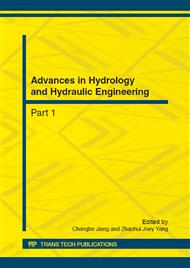[1]
Trenhaile A S: Coastal dynamics and Landforms. Oxford: Oxford University Press, 1997.
Google Scholar
[2]
M.E. Ren: Mans impact on the coastalzone of the Mississippi river delta, Acta geographica sinica, Vol.42(1989), pp.221-230.
Google Scholar
[3]
Stanley.D.J and Warne.A.G:Nile delta in its destruction phase. Journal of Coastal Research, Vol.14(1998), pp.794-825.
Google Scholar
[4]
Fanos A M: The impact of human activities on the erosion and accretion of the Nile delta coast. Journal of Coastal Research. Vol.11(1995), pp.821-833.
Google Scholar
[5]
Z.S. Yang, H.J. WangY.Shao: Phase change of the modern Huanghe River delta evolution since its last end channel shift in 1976(and its phase change). Jarupongsakul T and Saito Y.Oroceedings of 5 International Comference on Asian Marine Geology, AGCP 475 Delta MAP and APN Mega-Delta. January 13-18, 2004, Bangkok, Thailand.
DOI: 10.1016/j.margeo.2021.106516
Google Scholar
[6]
C.L. Qian: Effects of the water conservancy projects in the luanhe river basin on luanhe river delta hebei province, Acta geographica sinica,Vol.49(1994),pp.158-166.
Google Scholar
[7]
S.L. YangJ.Zhu, Q.Y. Zhao: A perlimenary study on the influence of Changjiang river sediment supply on subaqueous delta-Evidences in late 20th century and an expectation for the coming decades, Acta oceanlogica sinica, Vol.25(2003),pp.83-94.
Google Scholar
[8]
P.Li,S.L. Yang, S.B. Dai: Accretion/erosion of the Suobaqueous Delta at the Yangtze Estuary in Recent Years, Acta geographica sinica, Vol.62(2007), pp.707-716.
Google Scholar
[9]
S.L. YangJ.Zhu, P.Li: Response of Tidal Bank on the Changjiang River Mouth Foreland to Drastic Decline in Riverine Sediment supply and Sea Level rise, Advances in marine science, Vol.23(2005), pp.152-158.
Google Scholar
[10]
Moore.G.T: Interaction of rivers and oceans: Paleocene petro leupotential,AAPG,Vol.53(1969), pp.452-459.
Google Scholar
[11]
C.X. Yun: The recent development rules of the Changiang Estuary, (1nd ed , Ocean Press, Bei jing 2004)pp.243-245.
Google Scholar
[12]
C.X.Li, S.Y. Yang, D.D. Fan, et al: The Change in Changjiang suspended load and its impact on the delta after completion of three-gorges dam, Quaternary Sciences, Vol.24(2004), pp.495-500.
Google Scholar
[13]
J.J. Fang, Y.T.Li, Z.H. Sun, J.Y. Deng: Analsis of Ronoff change Characteristics at Datong Station of Yangtze River[J], Water Resources and Power, Vol.29(2011), pp.9-13.
Google Scholar
[14]
C.X. Yun: China River delta crisis, (1nd ed , Ocean Press, Bei jing 2010)pp.10-11.
Google Scholar
[15]
E.F. Zhang, X.Q. Chen: Changes of Water Discharge between Datong and the Changjiang Estuary during the Dry Season, Acta geographica sinica, Vol.58(2003), pp.231-238.
Google Scholar
[16]
J.Liu, J.Y. Chen, Z.Y.Xu: River-bed evolution in the braided reach of the south and north passage after implementing Yangtze estuary deepwater navigational improvement, Advances in Water Science, Vol.19(2008), pp.605-612.
Google Scholar


